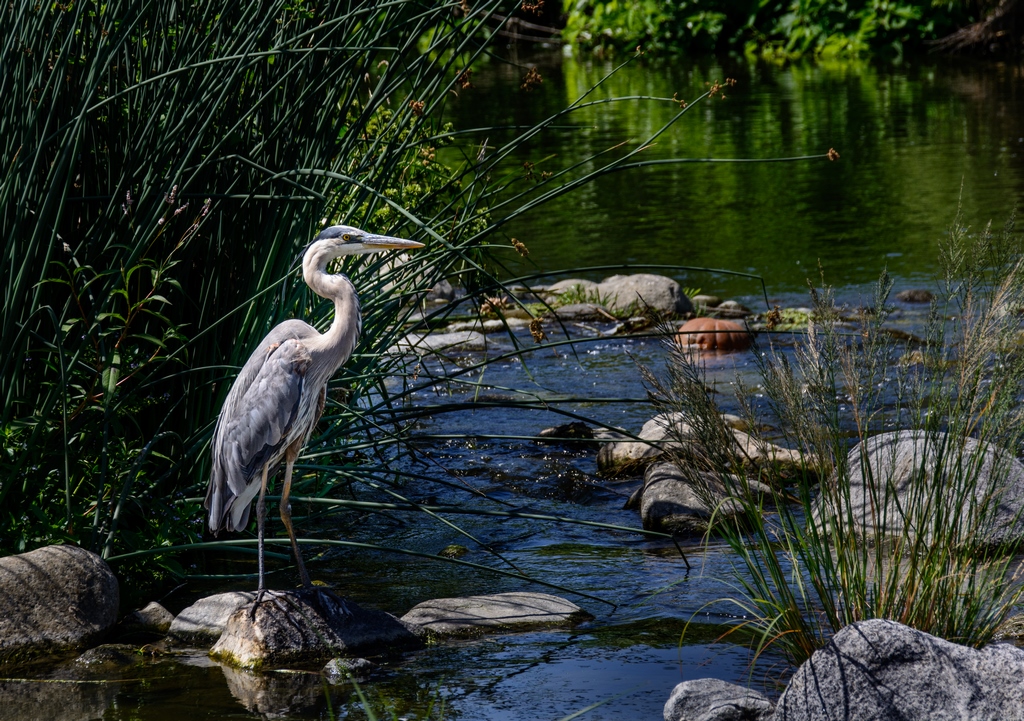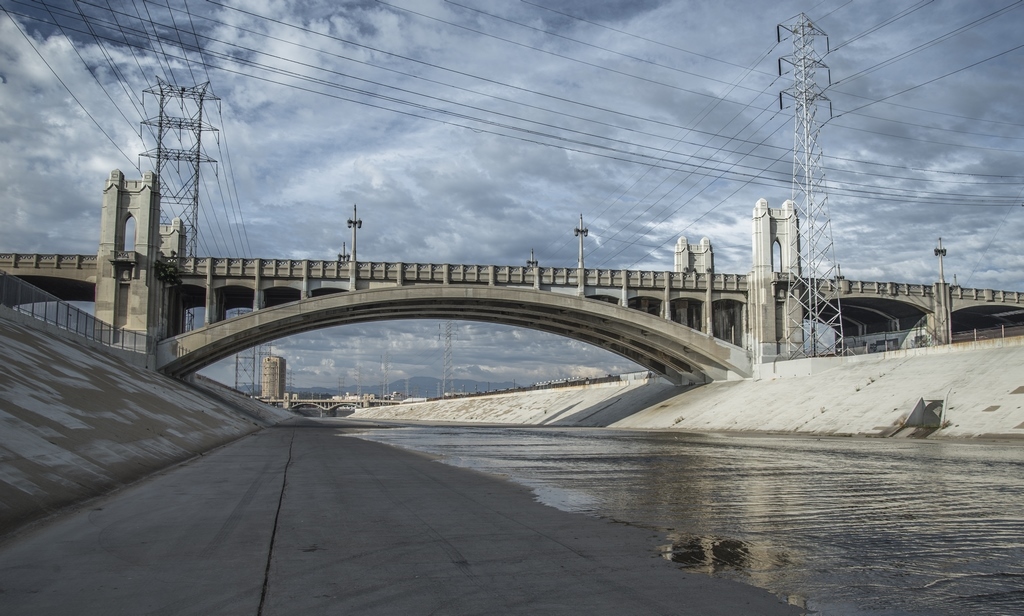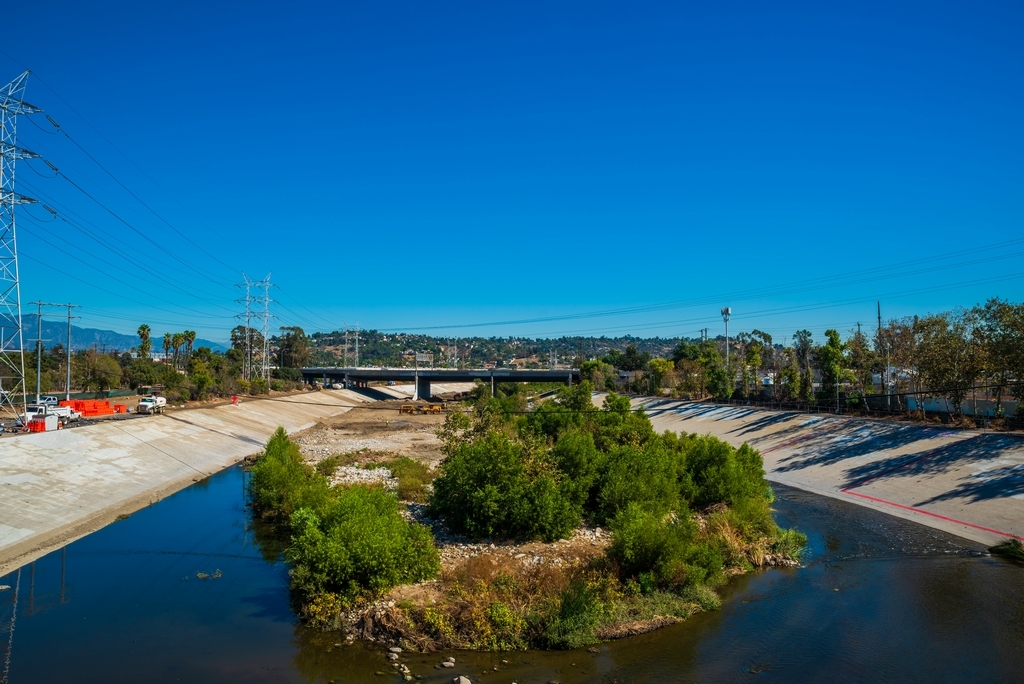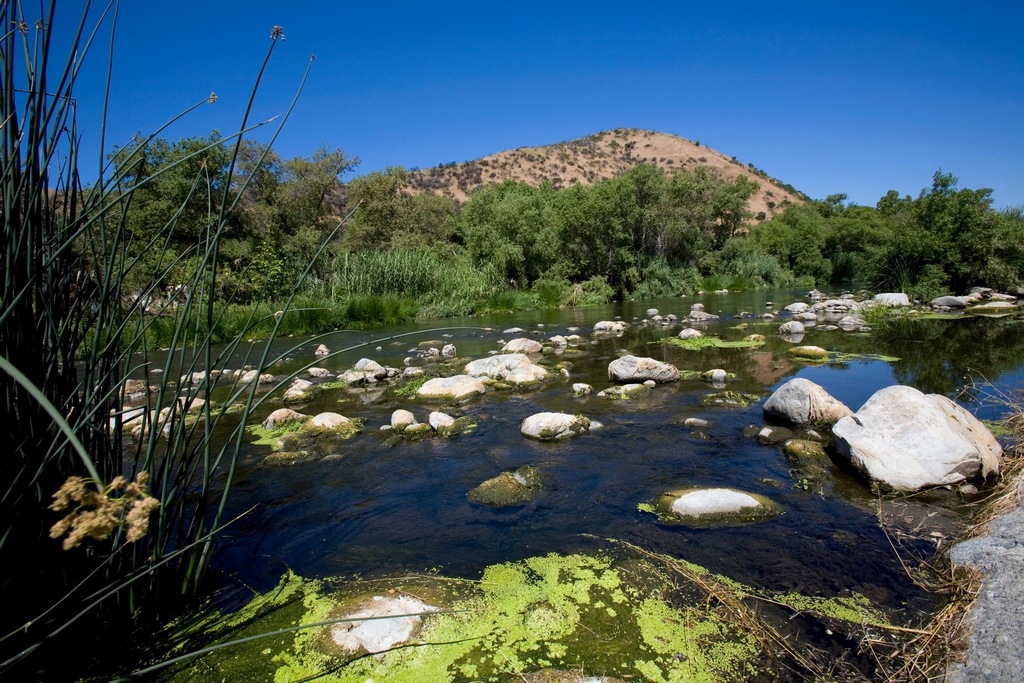Restoring the LA River


For most of the past century, natural waterways in Southern California have existed as lifeless concrete channels. Efforts to “regreen” some of those once-beautiful waters have given rise to hopes that the Los Angeles River, and others like it, will one day recapture their former natural health and riparian beauty.
By Eric Herman
It happened long ago. The Los Angeles River, once a vibrant and ecologically diverse waterway, fell victim to the modern world. In an effort to control flooding and facilitate urbanization, the river underwent extensive “channelization” over several decades in the early and mid-20th century, leading to the complete destruction of its natural ecosystems.
Even for us area natives of a certain age who fondly remember the era of orange groves and golden meadows, the LA River has only ever been an enormous concrete ditch. The hardscape embankments and riverbed were great for riding bikes and skateboards, but nothing about the LA River and its companion to the south, the Santa Ana River, were anything approaching natural.
Things have changed in recent years, however, as the benefits of regreening rivers has driven action throughout the U.S. and elsewhere. The 51-mile long LA River now stands as an inspiring example of river restorations.
Since 2007, the City of Los Angeles, along with a consortium of interested agencies, private sector companies and community activists have mounted a remarkable effort to restore the waterway to a more natural and healthy state. The LA River is far from alone. Riparian restoration efforts unfold the world over in countless rivers in various states of degradation. It is, however, a highly visible and decidedly dramatic example.
In many ways, it’s an experiment with potentially far-reaching implications. After all, if a completely dead river running through the heart of one of the world’s largest metropolitan areas can be restored, it’s likely possible almost anywhere.
LONG RUNNING
The LA River has a rich and complex history. It is why downtown Los Angeles is where it is, nestled far inland as opposed to located on the ocean. The river’s banks were originally inhabited by various Native American tribes, including the Tongva and the Chumash. They relied on the river for sustenance, using its resources for food, water, and transportation.
Spanish explorers, including Gaspar de Portolà and Father Junipero Serra, founder of the California Missions, arrived in the area in the late 18th century, beginning the steady march to the river’s subjugation. Spanish settlers established missions and ranchos, influencing the use of the river for agriculture and irrigation.
After gaining independence from Spain, Mexico took control of California. With the Treaty of Guadalupe Hidalgo in 1848, California became part of the United States. During this period, the river played a crucial role in the development of the region, with ranchos utilizing its waters for irrigation and transportation to the rapidly developing Port of Los Angeles.
The early 20th century saw rapid urbanization in Los Angeles and the river got in the way, posing a significant threat due to periodic flooding. Long before the days of environmental awareness and preservations, engineers began channelizing the river, removing its natural bends and covering it in reinforced concrete, a process that continued over the decades.
Plant and wildlife diversity and quality were decimated, with ripple effects throughout the region as the entire river system was disconnected from its floodplain and significant ecological zones. With so much of the surrounding landscape being developed at a blinding pace, the ecological devastation went largely unnoticed.
Nevertheless, the river still played a part in local culture. It even famously became a popular backdrop for Hollywood films, including iconic scenes in movies like “Grease” and “Terminator 2.” Its concrete channels, though originally designed for flood control, became an ironic and even dystopian symbol of the city.
Starting in the late 20th century, community groups, environmentalists, and government agencies have collaborated on projects to turn back time and reintroduce natural elements, improve water quality, and create recreational spaces along the river.
BACK TO NATURAL
Those efforts crested in 2007 when the city adopted the “Los Angeles River Revitalization Master Plan,” an ambitious blueprint outlining a comprehensive vision for the river’s future. The plan emphasizes sustainable development, habitat restoration, and the creation of public spaces.
It’s a massive project that is unfolding in pieces. The Ecosystem Restoration Project, for example, involves restoring 11 miles of the river from approximately Griffith Park to downtown Los Angeles, while maintaining existing levels of flood risk management. It is currently the centerpiece of the overall restoration effort.
The project includes creation and reestablishment of historic riparian strands and freshwater marsh habitats capable of supporting increased and varied populations of wildlife while enhancing habitat connectivity to nearby ecological zones, in places such as the Santa Monica Mountains, Verdugo Hills, Elysian Hills, and San Gabriel Mountains.
Those efforts include a complex hydrological plan to reconnect the river to historic floodplains and tributaries, while reducing flow velocities, increasing natural -filtration , improving natural sediment processes, and ultimately elevating water quality.
Despite such ambitious restoration efforts, challenges persist, including pollution, invasive species, and the need for continued flood control.
VESTED RETURNS
Why is restoring a river to a natural riparian condition worth all that effort? Some of the answers are obvious and all encompassing, others are far less obvious.
Reverting to a more natural state allows for the reintroduction of native vegetation, creating habitats that support a diverse range of flora and fauna. This fosters biodiversity, including the revival of endangered species.
Natural rivers provide conducive environments for fish migration, crucial for the reproduction and survival of various aquatic species. Restoring the LA River’s natural features can revive migratory pathways, benefiting fish populations.
Healthy riparian systems act as effective filters, trapping pollutants and sediments. Reintroducing natural vegetation along the LA River can enhance water quality by reducing the influx of pollutants from urban runoff. In other words, revitalizing rivers will improve conditions in the ocean proximate to their outlets, deltas and wetlands.
Almost entirely unseen, but a benefit of epic proportions, rivers contribute to groundwater recharge by allowing water to percolate into the soil. This process replenishes aquifers, ensuring a sustainable and reliable water supply for both human and natural systems. In an area prone to historic drought conditions, sustaining ground water resources is essential.
A restored LA River also offers opportunities for recreational activities such as hiking, biking, and bird watching. This not only benefits the community at large, but also inspires a sense of connection between residents and their natural surroundings.
And, a revitalized river can serve as an educational resource, promoting environmental awareness and fostering a deeper understanding of the region’s natural history and ecology.
RESORATION TECHNIQUES
The U.S. Department of Agriculture defines riparian restoration as “the reestablishment of riparian functions and related physical, chemical, and biological linkages between terrestrial and aquatic ecosystems; it is the repairing of the diversity and dynamics of indigenous ecosystems degraded by human impacts. Its goal is to ensure that the dynamics of natural ecosystem processes are again operating efficiently so that both ecosystem structure and functions can be recovered and sustained.”
Restoring rivers that have been completely covered in concrete is an extreme example of that process. There are a number of specific measures needed to regenerate a sustainable natural environment.
- Introducing native plant species is crucial for restoring the natural balance of the ecosystem. The planting palettes are adapted to the local climate, soil conditions, and play a key role in supporting wildlife.
- Creating a well-defined riparian corridor along the riverbanks helps stabilize the soil, reduce erosion, and provide essential habitat for diverse flora and fauna.
- Reintroducing natural meanders to the river’s course promotes a more dynamic flow, which aids in sediment transport, promotes nutrient cycling, and supports diverse aquatic habitats.
- Allowing the river to access its historic floodplain during periods of high flow helps prevent flooding downstream, reduces erosion, and supports the development of wetland ecosystems.
- Implementing green infrastructure, such as permeable surfaces and vegetated swales, helps manage stormwater runoff. This reduces the volume of pollutants entering the river and mitigates the impacts of urbanization.
CONFLUENT EFFORTS
Raising awareness about the benefits of river restoration through educational programs and outreach initiatives is crucial for garnering public support and participation. Coordinating efforts among various stakeholders, including government agencies, environmental organizations, and local communities, is essential for developing comprehensive and effective restoration plans.
Advocating for policies that prioritize river restoration, sustainable urban development, and the protection of natural ecosystems is crucial for creating a supportive legal framework.
Collaborative efforts between urban planners and environmentalists can lead to sustainable urban design that prioritizes the health of the river ecosystem. This includes the incorporation of green spaces and sustainable drainage systems.
Involving local communities in the restoration process ensures that their needs and concerns are addressed. This fosters a sense of ownership and responsibility for the river’s well-being.
For these and other reasons restoration of the LA River stands as a testament to the potential for harmonizing urban development with the preservation of natural landscapes, paving the way for a more sustainable and resilient future.
Sources: “Readers Guide: LA River Ecosystem Restoration Project” April 2106, and “LA River Ecosystem Restoration” May 2021, available as PDFs at www.riverla.org.
Opening photo by BBPrince | Shutterstock, 2nd photo by Greet Llegems | Shuttertock | 3rd photo by Ansel B | Shutterstock; bottom photo by William Yohe | Shutterstock.













